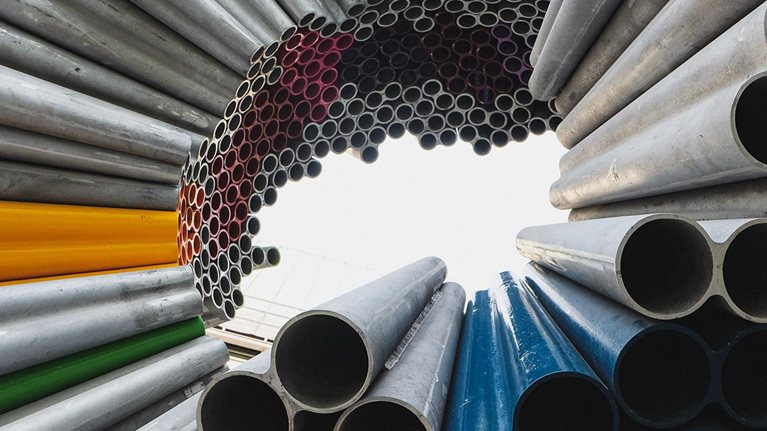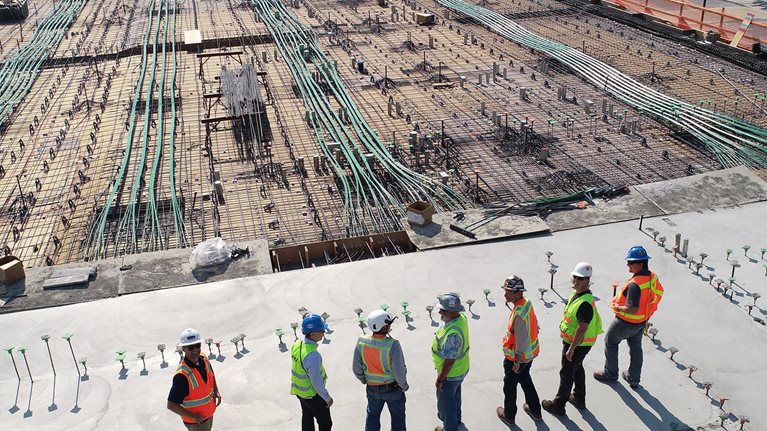The future of the construction industry is a decarbonized one—and it’s approaching fast. Scottish Water, Scotland’s national public water and wastewater service, has set the ambitious deadline of achieving net-zero construction by 2040. As construction companies around the world set their own decarbonization targets, industry leaders are looking for strategies to help them meet these goals—or just get started. Perhaps most surprising, however, is how achievable net-zero emissions goals are and how effective high-level strategy can be when it’s communicated properly.
In an effort to better understand these strategies, McKinsey’s Focko Imhorst and Anna Orthofer spoke with Scottish Water’s Gordon Reid, general manager of zero emissions, and Mark Williams, sustainability and climate change manager, about financing the costs of decarbonization, sourcing low-carbon materials, and attracting and retaining talent.
McKinsey: Scottish Water’s targets of achieving a net-zero capital program by 2040 are higher than the announced goals of the UK construction industry. What motivated you to make this commitment, and how does it sit within the broader mission of Scottish Water?
Gordon Reid: Like most organizations, we previously focused on addressing our operational emissions. But as we built our intelligence, it became quite clear that our capital-program emissions were not only significant but also poised to become the largest single contributor to our overall emissions. We knew we needed to act on both and to look at the wider picture.
Mark Williams: Our focus on capital-investment emissions differentiates us. We first started to think about this back in the late 2000s. The water sector has a large incumbent asset base, and operational emissions are just one dimension of that. The continued year-on-year investment in the asset base is essentially an ongoing cost, and it results in emissions that we have to take responsibility for.
It’s not just Scottish Water. Other parts of the UK water industry have recognized aspects of this and then helped define the rules. Since then, we and one or two others have gone further. We see these ongoing investments as something we must make every year to maintain the asset base and also to improve it and address the resulting emissions.
McKinsey: What are the biggest opportunities for progress, and where do you foresee the greatest challenges and risks?
Gordon Reid: I think the biggest opportunities are linked to reducing capital-program emissions. The approach we take is threefold: we challenge our teams to develop the lowest-carbon solution to a problem, build it with the lowest-carbon materials, and use the lowest-carbon construction techniques.
The biggest challenge is addressing behavior, both for people and organizations. If an engineer has spent years designing conventional reinforced concrete, you’ve got to take them on a journey to look at the problem differently. Although I see an alternative material as an opportunity to reduce emissions, our supply chain partners look at that as a potential risk and liability. So you need to have a conversation with them that explores the commercial aspects of the transition, which can be challenging. The good news is that once you actually start conversations, they build momentum on their own.
Mark Williams: Building a coalition of infrastructure providers in Scotland is also a big opportunity. If we can start doing that by building demand for the right materials, then together with the supply chain we can start moving forward.
Gordon Reid: A longer-term question is how the cement, steel, and plastics sectors will fully decarbonize their products. There are some pathways available now, but we’re a long way from where we would like to be. These sectors will need to make significant investments across their asset base, which is going to take time. But ultimately, we’re not going to be able to deliver net-zero construction without those key investments. And it’s difficult to influence them because we’re so far removed from the primary production facilities.
McKinsey: What have been the biggest insights or surprises since you embarked on your decarbonization journey?
Gordon Reid: The more you understand the different decarbonization pathways for different materials, the more you see that net-zero construction is achievable. The challenge is one of time: When will green steel and green cement be readily available? The surprise is seeing what our project teams can do now to decarbonize construction. They’re thinking outside the box, rising to the challenge, and coming up with lots of ways to reduce carbon, and often significantly.
McKinsey: How are you thinking about the costs of decarbonization? And how will you finance those costs?
Gordon Reid: Decarbonizing construction has been a bit of an open-ended question and an area of uncertainty when it comes to the cost of delivering it. The World Economic Forum forecasts it will take a 3 percent premium on construction, and the UK’s Climate Change Committee says to get to net zero, it will take 1 to 2 percent of GDP.
Based on these forecasts and the intelligence we have, we think decarbonization will cost about 1 percent of our capital program over the next 20 years. Now, when you put that into the context of the time scale of our investment program, it’s not frightening. We can reframe that cost premium as “It’s just the way we do business,” because the time will come when the only steel you buy will be green steel. The market will shift, and as it matures, it will become stable.
McKinsey: As a local buyer, how are you working with your supply chain to source low-carbon materials and equipment?
Gordon Reid: We’ve made reducing carbon one of the key incentives for our contractor partners. And we have also asked our 400 framework suppliers to develop carbon-reduction plans, which will hopefully accelerate the development of lower-carbon alternatives that our construction partners can use.
On the supply side, we look to work with other clients to stimulate the market. If we can signal to the market that we all want to buy a low-carbon version of a specific material, then that will incentivize that part of the supply chain to think about making their materials available in our part of the world.
Engagement with our delivery partners is very much at an executive level, sharing our longer-term strategy and goals with them and looking for alignment. Many of these construction organizations have decarbonization targets of their own, so there is an immediate connection. That said, sometimes the grassroots within these organizations don’t want to push a low-carbon initiative because they think their executives won’t buy into it—but in reality it’s exactly what their executives want.
Behavior is a massive challenge here. The safe thing is to do what is conventional. The more difficult thing is to do something different. But if your leadership is saying, “Please, this is what we want you to do,” and a client is saying, “This is what we want you to do,” it’s easier for people to step out of their comfort zones.
Mark Williams: When there’s genuine enthusiasm and interest among people at the executive level to have these conversations on a regular basis and to make it a point in every meeting, other people will come forward with ideas. It’s not just focusing on those that are doing well; it’s giving guidance so all of the supply chain can participate in the journey, including those that genuinely don’t know where to start.
McKinsey: A lot of what we hear from executives has to do with attracting talent to construction and capital projects by illustrating the impact they can have on decarbonization and net-zero goals. How has this affected the people you work with?
Gordon Reid: It’s given them headroom to do things they previously felt they weren’t allowed to do. The younger cohort are much more environmentally aware, and what we are able to do is give the signal that says, “We want you to do this. We want to deliver for 2040, and we need you to rise to the challenge.”
Don’t just expect your people to deliver. You’ve got to constantly challenge them. In every construction meeting, there is a health and safety moment where you discuss milestones, progress, and risks. We need to do the same thing for carbon. We need to continually ask, “What have you done this week in your projects to take carbon out?”
Mark Williams: You can have a challenging target in 2040, and people think that’s a long way away and they don’t have to worry about it. But there are things that need to happen today, tomorrow, next week, and next month to help us on that journey.
McKinsey: How are you planning to scale innovation to accelerate your decarbonization journey?
Gordon Reid: To begin, you need to segment your construction portfolio. If you’re dealing with a huge construction project, your carbon-reduction pathway will be very complex. Know the carbon in your project and know what levers you can pull to make a difference—there’s a huge amount of innovation that will be driven by that. And engage your supply chain. There may be a thousand components in your project, but when you break it down into the discrete components, you’d be amazed at what you can do. The art of the possible is growing every day.
McKinsey: What is your advice for other capital leaders pursuing complex decarbonization ambitions?
Mark Williams: Gather the information, but don’t worry about the precision. Get something down and allow yourself to always focus on the top issues. As you get those under control, you can move on to the next one. The data journey is long and will never be perfect. The important thing is to start.
Gordon Reid: Nothing succeeds like success. Once people can see that something works, they’ll follow it through. Similarly, once a project team sees how simple it can be to take carbon out just by looking at things a bit differently, they will do it again on the next project.
Once we started talking about safety, we improved safety. So let’s talk about carbon.
This article is part of Global Infrastructure Initiative’s Voices on Infrastructure.


